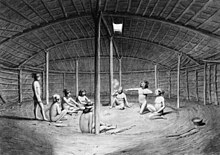Kuksu cult
The Kuksu cult (also: Kuksu ) was a religion in Northern California , which was practiced by the members of various indigenous peoples of California before or during the first contact with European settlers. The religious belief system has been maintained by various tribes and groups in central and northern California from the Sacramento Valley to the Pacific Coast.
The practice of the cult included elaborate narrative ceremonial dances and special regalia. The people of the tribes and groups practiced rituals to ensure health, abundant harvests and hunts, fertility and good weather. The ceremonies included an annual mourning procedure, rites of passage, and the intervention of spirits . A male secret society met in underground dance rooms and danced in disguise at public dances.
Kuksu has been identified archaeologically through finds from underground dance rooms and wooden dance drums.
Northern Kuksu cult
Patwin
The Patwin culture in Northern California practiced comparatively strict and remarkable kuksu systems and rituals.
Maidu
The Maidu culture in Northern California practiced comparatively strict and remarkable kuksu systems and rituals.
Pomo
Kuksu was personified by the Pomo with a spirit being. Their mythology and dance ceremonies - including the spirit of Kuksu or Guksu - have been attested between 1892 and 1904. The name Kuksu (depending on the dialect also Guksu ) was used for a red-beaked supernatural being who lived in a sweat lodge at the southern end of the world. Healing was his job and his specialty. The person who embodied the Kuksu / Guksu in the Pomo dance ceremonies was probably often the medicine man who, prepared as such, visited the sick. A ceremonial dance was named after him. He also appeared briefly at most of the ceremonies to carry away the diseases of the village.
All men were expected to join a ceremonial society; some of the dances were private or secret from women and girls. In research there are different opinions about the power of these societies within the tribe: “ There was no secret society of importance as there was among the Maidu and presumedly among the neighboring Wintun , and no organized priesthood vested with control over ceremonies. for example: There was no secret society of any importance as with the Maidu and possibly with the neighboring Wintun , also no organized priesthood to which the control of the ceremonies was transferred. ”In contrast, a witness from Clear Lake Pomo said in 1925:“ The heart of religious activities lay in a secret society called kuhma , akin to that of the Patwin and Maidu and composed chiefly of men, which managed the ritual of the ancient hindil or kuksu religion. for example: The core of religious activities was the responsibility of a secret society, called kuhma , related to those of the Patwin and Maidu and mainly made up of men who led the ritual of the earlier Hindil or Kuksu religion. "
Southern Kuksu cult
The ethno-historian Alfred L. Kroeber observed that Kuksu did exist, but with less “socialized cosmogony ” in the “southern Kuksu dance groups” of the Muwekma Ohlone , Salinan , Miwok and Esselen and the northernmost Yokuts than in the groups in northern California and northern Sacramento Valley.
swell
- Barret, Samuel A. "Ceremonies of the Pomo Indians," edited by University of California Publications in American Archeology and Ethnicity, July 6, 1917, Vol. 10, pp. 397-441. Thi Stephen Powers.
- Kroeber, Alfred L. The Kuksu Cult . Paraphrased. Maidu Culture [1]
- Kroeber, Alfred L. 1907. The Religion of the Indians of California , University of California Publications in American Archeology and Ethnology 4: # 6. Berkeley, Sections "Shamanism", "Public Ceremonies", "Ceremonial Structures and Paraphernalia", and "Mythology and Beliefs"; available from Sacred Texts Online
- Kroeber, Alfred L. 1925. Handbook of the Indians of California . Washington, DC: Bureau of American Ethnology Bulletin No. 78; (The chapter on the Miwok is available from Yosemite Online Library - covers Kuksu, among others)
- Gifford, Edward W. 1926. Clear Lake Pomo Society , University of California Publications in American Archeology and Ethnology 18: 2 pp. 353-363 "Secret Society Members" (describes EM Loeb's 1925 study of the practice of Clear Lake Pomo of the "Guksu [sic] religion ".)
literature
- Christian F. Feest : Animated Worlds - The religions of the Indians of North America . In: Small Library of Religions , Vol. 9, Herder, Freiburg / Basel / Vienna 1998, ISBN 3-451-23849-7 .
Individual evidence
- ^ A b c Kroeber, Alfred L. The Religion of the Indians of California , 1907.
- ↑ The Kuksu Cult paraphrased from Kroeber. Archived from the original on October 11, 2006 ; Retrieved December 5, 2017 .
- ↑ Barret (1917): 423, 430-431
- ↑ Barret 398
- ^ Gifford 353
- ↑ Kroeber (1925) 445: "It is true the Costanoan and Salinan stocks, who participate in the Kuksu cult and live in the same transverse belt of California as the Miwok, seem also to lean in their mythology toward the Yokuts more than to the Sacramento Valley tribes. A less specialized type of cosmogony is therefore indicated for the southern Kuksu-dancing groups. [1. If, as seems probable, the southerly Kuksu tribes (the Miwok, Costanoans, Esselen, and northernmost Yokuts) had no real society in connection with their Kuksu ceremonies, the distinctness of their mythology appears less surprising.] "

